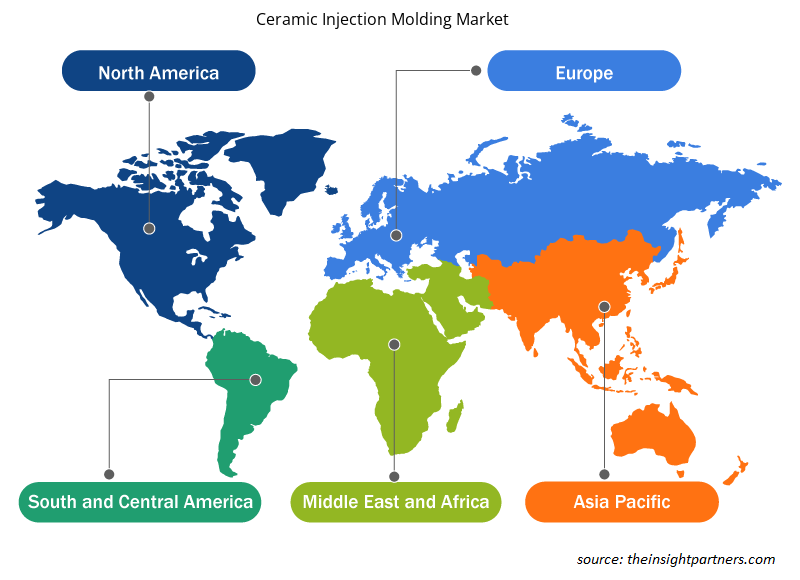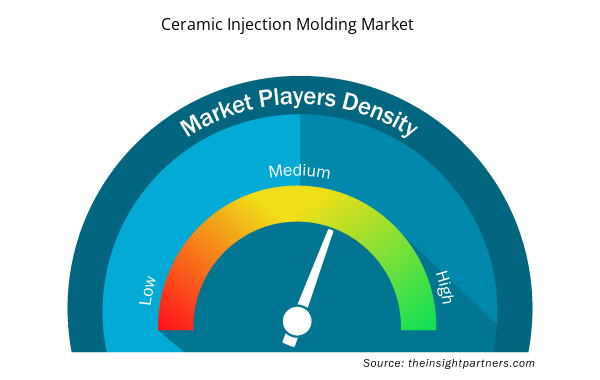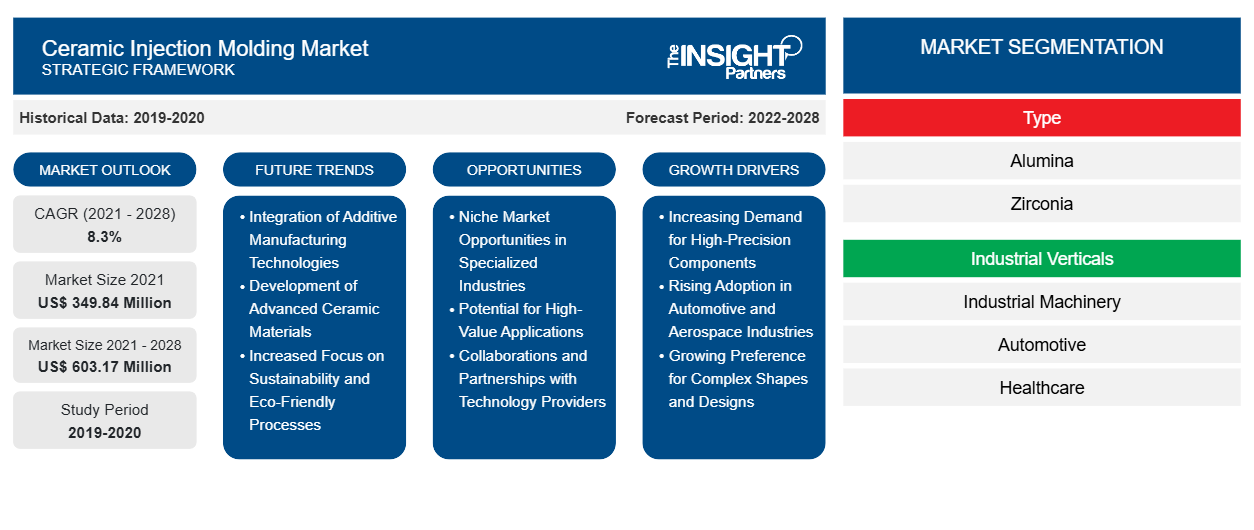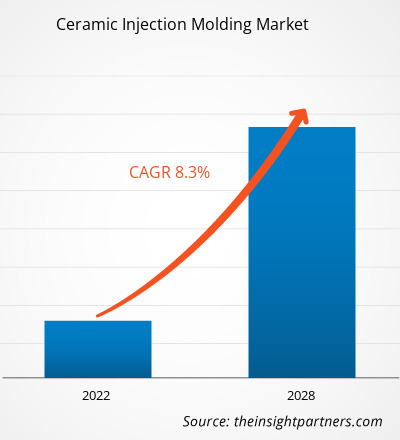Der Markt für Keramikspritzguss soll von 349,84 Millionen US-Dollar im Jahr 2021 auf 603,17 Millionen US-Dollar im Jahr 2028 anwachsen. Von 2022 bis 2028 wird eine durchschnittliche jährliche Wachstumsrate (CAGR) von 8,3 % erwartet.
Die Nachfrage nach Keramikspritzguss steigt aufgrund der zahlreichen Vorteile, die Keramikspritzguss bietet. Die zunehmende Anwendung von Keramikspritzguss in der Automobil- und Elektronikindustrie in Industrie- und Entwicklungsregionen dürfte lukrative Möglichkeiten für das Marktwachstum bieten. Der asiatisch-pazifische Raum dominierte den Markt in Bezug auf den Umsatz und dürfte im Prognosezeitraum auch die am schnellsten wachsende Region sein. Das Segment Aluminiumoxid dominiert den Markt. Das Wachstum des Segments Zirkonoxid dürfte sich positiv auf das Marktwachstum auswirken.
Im Jahr 2021 hielt Europa den größten Anteil am globalen Markt für Keramikspritzguss , und der asiatisch-pazifische Raum wird im Prognosezeitraum voraussichtlich die schnellste CAGR verzeichnen. Im Jahr 2019 hatte der asiatisch-pazifische Raum den größten Anteil am globalen Markt für Keramikspritzguss. Das Wachstum des Marktes für Keramikspritzguss in dieser Region ist hauptsächlich auf die breite Verfügbarkeit von keramischen Materialien wie Aluminiumoxid und Zirkonoxid zu reduzierten Kosten zurückzuführen. Die zunehmende Anwendung des Keramikspritzgusses bei der Herstellung von medizinischen Instrumenten und Unterhaltungselektronik begünstigt die Nachfrage im asiatisch-pazifischen Raum. Die technologischen Fortschritte und der steigende Trend zur Verwendung fortschrittlicher Produkte kurbeln die Nachfrage nach Keramikspritzguss an. Abgesehen davon ist die zunehmende Anwendung des Verfahrens im Gesundheitswesen, im Industriemaschinenbau, im Automobilbau und bei Konsumgütern ein weiterer Faktor, der reichlich Möglichkeiten für das Wachstum des Keramikspritzgusses in der Region bietet.
Passen Sie diesen Bericht Ihren Anforderungen an
Sie erhalten kostenlos individuelle Anpassungen an jedem Bericht, einschließlich Teilen dieses Berichts oder einer Analyse auf Länderebene, eines Excel-Datenpakets sowie tolle Angebote und Rabatte für Start-ups und Universitäten.
- Holen Sie sich die wichtigsten Markttrends aus diesem Bericht.Dieses KOSTENLOSE Beispiel umfasst eine Datenanalyse von Markttrends bis hin zu Schätzungen und Prognosen.
Markteinblicke
Stärkere Technologienutzung in der Automobil- und Elektronikindustrie
Keramikspritzguss wird in vielen Branchen wie der Automobil-, Elektronik- und Konsumgüterindustrie eingesetzt. Mit der Keramikspritzgusstechnologie können hochpräzise, komplexe Keramikkomponenten und -teile für die Elektronik-, Mobiltelefon- und Konsumgüterindustrie hergestellt werden. In den letzten Jahren hat die Produktion von tragbaren Computergeräten, Mobiltelefonen, Spielsystemen und anderen persönlichen elektronischen Geräten exponentiell zugenommen. Daher treibt die zunehmende Verbreitung dieser Produkte die Expansion der Keramikspritzgussindustrie voran. Die schnelle Urbanisierung hat außerdem zu einer zunehmenden Verbreitung von Mobiltelefonen, elektronischen Artikeln, Fahrzeugen und anderen Produkten geführt. Das enorme Wachstum der Automobilindustrie in Verbindung mit der enormen Produktionsnachfrage nach dieser Technologie hat positive Auswirkungen. Die Nachfrage nach Miniaturformprodukten steigt im Automobilsektor, was auf ihre hohe Festigkeit und Komplexität in ihren Strukturen zurückzuführen ist. Komplexe und wichtige Komponenten in elektronischen Systemen, Motoren und Verriegelungsmechanismen werden normalerweise im Spritzgussverfahren hergestellt, was ein erheblicher Treiber für die Expansion des Keramikspritzgussmarktes ist. Technische Keramik funktioniert effizient unter extremen Bedingungen wie hohen Temperaturen, korrosiven Atmosphären und abrasiven Bedingungen. Darüber hinaus zeichnet sich Hochleistungskeramik durch hervorragende mechanische Eigenschaften bei geringem spezifischem Gewicht aus. Aufgrund dieser Eigenschaft gelten Hochleistungskeramiken als Leichtbaumaterialien und finden daher Anwendung in beweglichen Luftfahrt- und Automobilkomponenten sowie Motorkomponenten. Darüber hinaus fördern steigende verfügbare Einkommen und ein verbesserter Lebensstandard in den Entwicklungsregionen das Wachstum dieser Endverbraucherbranchen und verstärken letztendlich das Marktwachstum.
Typbasierte Erkenntnisse
Basierend auf dem Typ wird der Markt für Keramikspritzguss in Aluminiumoxid, Zirkonoxid und andere unterteilt. Das Segment Aluminiumoxid hatte 2021 den größten Marktanteil . Das Segment Zirkonoxid wird im Prognosezeitraum voraussichtlich die höchste durchschnittliche jährliche Wachstumsrate verzeichnen. Zirkonoxid, auch bekannt als Zirkonia, ist ein weißes kristallines Oxid von Zirkonium . Das Mineral Baddeleyit ist die am natürlichsten vorkommende Form von Zirkonoxid mit einer monoklinen Kristallstruktur. Keramikpulver aus Zirkonoxid wird häufig im Spritzguss verwendet. Zirkonoxid besitzt im Vergleich zu Aluminiumoxid eine größere Wärmeausdehnungskapazität. Es ist biokompatibel und weist eine hohe chemische Inertheit, hohe Bruchfestigkeit und geringe Wärmeleitfähigkeit auf. Zirkonoxidpulver wird bei der Herstellung von Zahnimplantaten im Spritzgussverfahren verwendet. Die Herstellung von Keramikspritzgussteilen unter Verwendung von mit Yttriumoxid stabilisiertem tetragonalen Zirkonoxid scheint machbar. Die Festigkeit und Variabilität von mit Yttriumoxid stabilisierten tetragonalen Zirkonoxidteilen ist im Vergleich zu anderen herkömmlichen Teilen normalerweise höher. Mullit-Zirkonoxid gilt aufgrund seiner hohen Thermoschockbeständigkeit, Hochtemperaturfestigkeit und seines niedrigen Wärmeausdehnungskoeffizienten als potenzielles Material für vertikale Hochtemperatur-Strukturindustrien. Das beim Spritzguss verwendete Zirkonoxidpulver besitzt die Fähigkeit, die komplexen Formen herzustellen, die aus den Mullit-Zirkonoxid-Verbundstoffen hergestellt werden. Das Zirkonoxidpulver wird hauptsächlich beim Spritzguss von Glasfaserhülsen und Drahtbondüsen verwendet. Die mit Zirkonoxid gehärtete Aluminiumoxidkeramik ist aufgrund ihrer Härte, hohen Festigkeit und Abriebfestigkeit ein interessantes Material für vertikale Biomedizin- und Maschinenbauindustrien. Aus diesem Grund scheint das Keramikspritzgießen eine attraktive Option zur Herstellung von mit Zirkonoxid gehärtetem Aluminiumoxid zu sein. Zirkonoxid wird hauptsächlich in vertikalen Industrien verwendet, in denen die Festigkeit von Aluminiumoxid als unzureichend angesehen wird.
Kategorie-Einblicke
Industrielle Einblicke in die Vertikale
Basierend auf den Industriezweigen ist der Markt für Keramikspritzguss in Industriemaschinen, Automobil, Gesundheitswesen, Elektro- und Elektronikgeräte, Konsumgüter und andere unterteilt. Das Segment Gesundheitswesen hatte im Jahr 2020 den größten Marktanteil. Die Verwendung von Keramikspritzguss in Zahnimplantaten, Pinzetten, endoskopischen Instrumenten und anderen Anwendungen unterstützt den Markt für Keramikspritzguss in der Gesundheitsbranche. Die Oxide von Zirkonoxid und Aluminiumoxid werden bei der Herstellung zahlreicher Geräte verwendet, was die Nachfrage nach Keramikspritzguss in der Gesundheitsbranche weiter antreibt. Die Fähigkeit des Keramikspritzgussverfahrens, die Rauheit und Oberflächenqualität der in Gesundheitsanwendungen verwendeten Komponenten zu modulieren, unterstützt das Wachstum des Marktes. Die wachsende Gesundheitsbranche ist ein weiterer Faktor, der lukrative Möglichkeiten für die Entwicklung dieses Segments bietet. Darüber hinaus fördern die Herstellung von mikrokeramischen Spritzgussteilen und deren Anwendung in verschiedenen Produkten der Gesundheitsbranche das Wachstum des Gesundheitssegments auf dem Markt für Keramikspritzguss.
Zu den wichtigsten Akteuren auf dem Markt für Keramikspritzguss gehören AMT Pte. Ltd.; Arburg GmbH + Ko. KG.; Ceramco, Inc.; CoorsTek, Inc.; Indo MIM; KLAGER; Micro; Morgan Advanced Materials; Nishimura; Advanced Ceramics, Co. Ltd.; und OECHSLER AG. Diese Unternehmen legen Wert auf die Einführung neuer Produkte und die geografische Expansion, um der weltweit steigenden Verbrauchernachfrage gerecht zu werden. Sie verfügen über eine weitverbreitete globale Präsenz, die es ihnen ermöglicht, eine große Anzahl von Kunden weltweit zu bedienen und so ihren Marktanteil zu erhöhen. Diese Marktteilnehmer konzentrieren sich stark auf die Einführung neuer Produkte und die regionale Expansion, um ihre Produktpalette in Spezialportfolios zu erweitern.
Regionale Einblicke in den Keramik-Spritzgussmarkt
Die regionalen Trends und Faktoren, die den Markt für Keramik-Spritzguss im Prognosezeitraum beeinflussen, wurden von den Analysten von Insight Partners ausführlich erläutert. In diesem Abschnitt werden auch die Marktsegmente und die Geografie des Keramik-Spritzgusses in Nordamerika, Europa, im asiatisch-pazifischen Raum, im Nahen Osten und Afrika sowie in Süd- und Mittelamerika erörtert.

- Erhalten Sie regionale Daten zum Keramik-Spritzgussmarkt
Umfang des Marktberichts zum Keramikspritzguss
| Berichtsattribut | Details |
|---|---|
| Marktgröße im Jahr 2021 | 349,84 Millionen US-Dollar |
| Marktgröße bis 2028 | 603,17 Millionen US-Dollar |
| Globale CAGR (2021 - 2028) | 8,3 % |
| Historische Daten | 2019-2020 |
| Prognosezeitraum | 2022–2028 |
| Abgedeckte Segmente | Nach Typ
|
| Abgedeckte Regionen und Länder | Nordamerika
|
| Marktführer und wichtige Unternehmensprofile |
|
Marktteilnehmerdichte: Der Einfluss auf die Geschäftsdynamik
Der Markt für Keramik-Spritzguss wächst rasant, angetrieben durch die steigende Nachfrage der Endverbraucher aufgrund von Faktoren wie sich entwickelnden Verbraucherpräferenzen, technologischen Fortschritten und einem größeren Bewusstsein für die Vorteile des Produkts. Mit steigender Nachfrage erweitern Unternehmen ihr Angebot, entwickeln Innovationen, um die Bedürfnisse der Verbraucher zu erfüllen, und nutzen neue Trends, was das Marktwachstum weiter ankurbelt.
Die Marktteilnehmerdichte bezieht sich auf die Verteilung von Firmen oder Unternehmen, die in einem bestimmten Markt oder einer bestimmten Branche tätig sind. Sie gibt an, wie viele Wettbewerber (Marktteilnehmer) in einem bestimmten Marktraum im Verhältnis zu seiner Größe oder seinem gesamten Marktwert präsent sind.
Die wichtigsten auf dem Markt für Keramik-Spritzguss tätigen Unternehmen sind:
- AMT Pte. Ltd.
- Arburg GmbH + Ko. KG.
- Ceramco, Inc.
- CoorsTek, Inc.
- Indo MIM
Haftungsausschluss : Die oben aufgeführten Unternehmen sind nicht in einer bestimmten Reihenfolge aufgeführt.

- Überblick über die wichtigsten Akteure auf dem Markt für Keramik-Spritzguss
Bericht-Spotlights
- Fortschrittliche Branchentrends im Markt für Keramikspritzguss helfen Unternehmen bei der Entwicklung wirksamer langfristiger Strategien
- Geschäftswachstumsstrategien der Marktteilnehmer für Keramikspritzguss in Industrie- und Entwicklungsländern
- Quantitative Analyse des Marktes von 2019 bis 2028
- Schätzung der weltweiten Nachfrage nach keramischen Spritzgussprodukten
- Porters Fünf-Kräfte-Analyse zur Veranschaulichung der Wirksamkeit von Käufern und Lieferanten auf dem Markt für Keramik-Spritzguss
- Aktuelle Entwicklungen zum Verständnis des wettbewerbsorientierten Marktszenarios
- Markttrends und -aussichten sowie Faktoren, die das Wachstum des Keramikspritzgussmarktes vorantreiben und bremsen
- Unterstützung im Entscheidungsprozess durch Aufzeigen von Marktstrategien, die das kommerzielle Interesse untermauern
- Größe des Keramik-Spritzgussmarktes an verschiedenen Knotenpunkten
- Ein detaillierter Überblick und die Dynamik der Keramik-Spritzgussindustrie
- Größe des Keramik-Spritzgussmarktes in verschiedenen Regionen mit vielversprechenden Wachstumschancen
- Historische Analyse (2 Jahre), Basisjahr, Prognose (7 Jahre) mit CAGR
- PEST- und SWOT-Analyse
- Marktgröße Wert/Volumen – Global, Regional, Land
- Branche und Wettbewerbsumfeld
- Excel-Datensatz



Report Coverage
Revenue forecast, Company Analysis, Industry landscape, Growth factors, and Trends

Segment Covered
This text is related
to segments covered.

Regional Scope
North America, Europe, Asia Pacific, Middle East & Africa, South & Central America

Country Scope
This text is related
to country scope.
Häufig gestellte Fragen
Rising awareness regarding the design flexibility and low-cost delivered by ceramic injection molding are estimated to provide potential market opportunities in the coming years. Various key players such as Indo-MIM, Coorstek, Inc., and many others are providing awareness regarding the cost-efficiency of the technology. Besides, the cost efficiency and complex designing capabilities of ceramic injection molding technology offer a higher economy of scale by eliminating the production steps such as machining and finishing. Ceramic injection molding is an innovative technology that provides economical solutions to produce complicated, repeatable ceramic parts and components. Also, the ceramic injection molding process is a highly flexible process to manufacture products that are considered difficult and expensive to produce using other conventional manufacturing techniques.
Based on the industrial verticals, healthcare segment is projected to grow at the fastest CAGR over the forecast period. The use of ceramic injection molding in prosthetic components offers the possibility to modulate the roughness or the surface quality on a singular component for combining various materials that can portray more homogenous mechanical properties. The simple shaped ceramic components for prosthetic dental components are manufactured by ceramic injection molding. Several injection molding zirconia ceramic tweezers pincers are also manufactured by many companies. Endoscopic ceramic insulators produced by ceramic injection molding are increasing adopted in the endoscopic surgeries conducted in hospitals.
Ceramic advantages offered by the ceramic injection molding is driving the ceramic injection molding market. ceramic injection molding employs dependable equipment and advanced ceramic materials as well as compounds to produce ceramic components in a carefully controlled environment. This results in products of exceptional quality that meets the quality and aesthetic standards specific to a particular industry. Besides, businesses attain financial benefits from high-volume manufacturing, especially if they require new components as an alternative to existing designs. In addition, ceramic injection molding also helps acquire custom-made moldings of exceptional durability that meet all the required industry criteria. Also, ceramic injection molding components offer all the benefits associated with technical ceramics, including corrosion resistance, wear resistance, superior hardness, thermal stability, high mechanical strength, and dimensional stability. Thus, the advantages offered by ceramic injection molding is augmenting the growth of the market.
The major players operating in the global ceramic injection molding market are AMT Pte. Ltd.; Arburg GmbH + Ko. KG.; Ceramco, Inc.; CoorsTek, Inc.; Indo MIM; KLAGER; Micro; Morgan Advanced Materials; Nishimura; Advanced Ceramics, Co. Ltd.; and OECHSLER AG
Europe accounted for the largest share of the global ceramic injection molding market. Europe has matured the automotive, aerospace, medical, and consumer electronics sector, and it is further supported by high technology connectivity environment. Along with the advancing technology, the trend of using advanced products is boosting the demand for ceramic materials and further influencing the market growth for the ceramic injection molding market. Additionally, the rising personal disposable income of the consumers has led to increasing demand for consumer electronic products. These factors boost the ceramic injection molding market in Europe.
Based on type, alumina segments mainly have the largest revenue share. The alumina components that are employed in ceramic injection molding possess high wear & corrosion stability, high surface finish quality and good electrical insulation. They are stable dimensionally and has the capacity to withstand high working temperatures. Owing to the good mechanical properties along with low specific weight, the ceramic injection molding alumina is used in engineering for sensor tubes, sensor covers and micro electrodes for ultrasonic welding. It is also used in textile industry for wire guides and textile thread guides. In electrical components it is used for microwave electric components. Ceramic insulation molding alumina is being highly demanded as it the most common used material in micro-CIM and 2C-CIM technologies.
Trends and growth analysis reports related to Chemicals and Materials : READ MORE..
The List of Companies - Ceramic Injection Molding Market
- AMT Pte. Ltd.
- Arburg GmbH + Ko. KG.
- Ceramco, Inc.
- CoorsTek, Inc.
- Indo MIM
- KLAGER
- Micro
- Morgan Advanced Materials
- Nishimura Advanced Ceramics, Co. Ltd.
- OECHSLER AG
The Insight Partners performs research in 4 major stages: Data Collection & Secondary Research, Primary Research, Data Analysis and Data Triangulation & Final Review.
- Data Collection and Secondary Research:
As a market research and consulting firm operating from a decade, we have published and advised several client across the globe. First step for any study will start with an assessment of currently available data and insights from existing reports. Further, historical and current market information is collected from Investor Presentations, Annual Reports, SEC Filings, etc., and other information related to company’s performance and market positioning are gathered from Paid Databases (Factiva, Hoovers, and Reuters) and various other publications available in public domain.
Several associations trade associates, technical forums, institutes, societies and organization are accessed to gain technical as well as market related insights through their publications such as research papers, blogs and press releases related to the studies are referred to get cues about the market. Further, white papers, journals, magazines, and other news articles published in last 3 years are scrutinized and analyzed to understand the current market trends.
- Primary Research:
The primarily interview analysis comprise of data obtained from industry participants interview and answers to survey questions gathered by in-house primary team.
For primary research, interviews are conducted with industry experts/CEOs/Marketing Managers/VPs/Subject Matter Experts from both demand and supply side to get a 360-degree view of the market. The primary team conducts several interviews based on the complexity of the markets to understand the various market trends and dynamics which makes research more credible and precise.
A typical research interview fulfils the following functions:
- Provides first-hand information on the market size, market trends, growth trends, competitive landscape, and outlook
- Validates and strengthens in-house secondary research findings
- Develops the analysis team’s expertise and market understanding
Primary research involves email interactions and telephone interviews for each market, category, segment, and sub-segment across geographies. The participants who typically take part in such a process include, but are not limited to:
- Industry participants: VPs, business development managers, market intelligence managers and national sales managers
- Outside experts: Valuation experts, research analysts and key opinion leaders specializing in the electronics and semiconductor industry.
Below is the breakup of our primary respondents by company, designation, and region:

Once we receive the confirmation from primary research sources or primary respondents, we finalize the base year market estimation and forecast the data as per the macroeconomic and microeconomic factors assessed during data collection.
- Data Analysis:
Once data is validated through both secondary as well as primary respondents, we finalize the market estimations by hypothesis formulation and factor analysis at regional and country level.
- Macro-Economic Factor Analysis:
We analyse macroeconomic indicators such the gross domestic product (GDP), increase in the demand for goods and services across industries, technological advancement, regional economic growth, governmental policies, the influence of COVID-19, PEST analysis, and other aspects. This analysis aids in setting benchmarks for various nations/regions and approximating market splits. Additionally, the general trend of the aforementioned components aid in determining the market's development possibilities.
- Country Level Data:
Various factors that are especially aligned to the country are taken into account to determine the market size for a certain area and country, including the presence of vendors, such as headquarters and offices, the country's GDP, demand patterns, and industry growth. To comprehend the market dynamics for the nation, a number of growth variables, inhibitors, application areas, and current market trends are researched. The aforementioned elements aid in determining the country's overall market's growth potential.
- Company Profile:
The “Table of Contents” is formulated by listing and analyzing more than 25 - 30 companies operating in the market ecosystem across geographies. However, we profile only 10 companies as a standard practice in our syndicate reports. These 10 companies comprise leading, emerging, and regional players. Nonetheless, our analysis is not restricted to the 10 listed companies, we also analyze other companies present in the market to develop a holistic view and understand the prevailing trends. The “Company Profiles” section in the report covers key facts, business description, products & services, financial information, SWOT analysis, and key developments. The financial information presented is extracted from the annual reports and official documents of the publicly listed companies. Upon collecting the information for the sections of respective companies, we verify them via various primary sources and then compile the data in respective company profiles. The company level information helps us in deriving the base number as well as in forecasting the market size.
- Developing Base Number:
Aggregation of sales statistics (2020-2022) and macro-economic factor, and other secondary and primary research insights are utilized to arrive at base number and related market shares for 2022. The data gaps are identified in this step and relevant market data is analyzed, collected from paid primary interviews or databases. On finalizing the base year market size, forecasts are developed on the basis of macro-economic, industry and market growth factors and company level analysis.
- Data Triangulation and Final Review:
The market findings and base year market size calculations are validated from supply as well as demand side. Demand side validations are based on macro-economic factor analysis and benchmarks for respective regions and countries. In case of supply side validations, revenues of major companies are estimated (in case not available) based on industry benchmark, approximate number of employees, product portfolio, and primary interviews revenues are gathered. Further revenue from target product/service segment is assessed to avoid overshooting of market statistics. In case of heavy deviations between supply and demand side values, all thes steps are repeated to achieve synchronization.
We follow an iterative model, wherein we share our research findings with Subject Matter Experts (SME’s) and Key Opinion Leaders (KOLs) until consensus view of the market is not formulated – this model negates any drastic deviation in the opinions of experts. Only validated and universally acceptable research findings are quoted in our reports.
We have important check points that we use to validate our research findings – which we call – data triangulation, where we validate the information, we generate from secondary sources with primary interviews and then we re-validate with our internal data bases and Subject matter experts. This comprehensive model enables us to deliver high quality, reliable data in shortest possible time.


 Holen Sie sich ein kostenloses Muster für diesen Bericht
Holen Sie sich ein kostenloses Muster für diesen Bericht